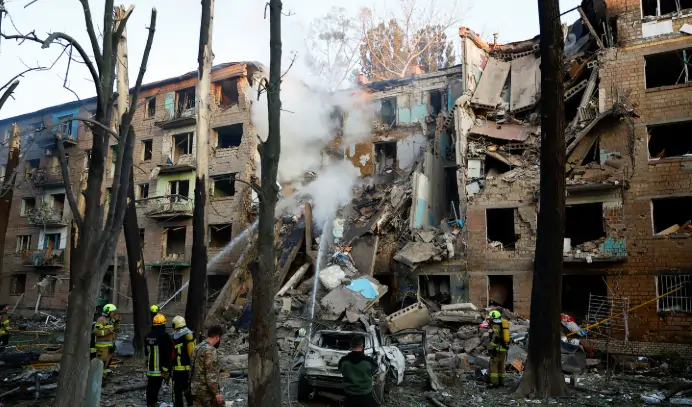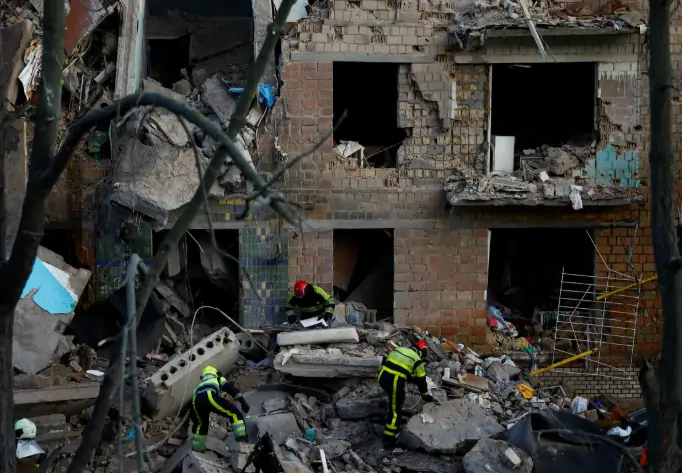
Russian Drone and Missile Barrage Rocks Ukraine’s Capital on June 23, 2025
Deadly Russian Strikes Hit Kyiv, In the early hours of Monday, June 23, 2025, Ukraine once again found itself under siege. A wave of deadly drone and missile strikes, launched by Russian forces, shook the capital city of Kyiv and its surrounding regions, leaving behind a path of destruction, fire, and grief. According to Ukrainian officials, at least five people were confirmed dead, and several others were injured as the strikes hit civilian areas, including a residential high-rise, a metro station entrance, and a community sports complex.
Deadly Russian Strikes Hit Kyiv mark a grim continuation of Russia’s intensified aerial bombardment campaign against Ukraine’s urban centers and infrastructure. Despite international condemnation and repeated calls for a ceasefire, Moscow’s attacks show no sign of abating, dragging Ukraine ever deeper into a worsening humanitarian crisis.

The Attack: A Night of Horror (Deadly Russian Strikes Hit Kyiv)
Timeline of the Bombardment
At about 3:30 a.m., residents were jolted awake as Deadly Russian Strikes Hit Kyiv—sirens wailed while drones and missiles tore through the sky. Ukrainian air defenses scrambled, yet several projectiles pierced the shield, proving how Deadly Russian Strikes Hit Kyiv can overwhelm even the best-prepared systems. By sunrise, smoke curled over multiple districts, residential blocks burned, and vital infrastructure lay in ruins—a stark reminder that Deadly Russian Strikes Hit Kyiv with devastating force.
Impact on Civilians
Deadly Russian Strikes Hit Kyiv inflicted their harshest blow in the capital’s Shevchenkivskyi district, where a direct missile impact sheared off part of a high-rise apartment complex. In an instant, entire walls crumbled, exposing shattered living rooms and bedrooms to the cold morning air. Emergency crews swarmed the scene, pulling four lifeless bodies from the debris while neighbors formed human chains to pass buckets of rubble and search for anyone still breathing beneath the twisted steel and broken concrete.
As hours stretched into afternoon, sirens wailed on repeat, helicopters circled overhead, and weary responders kept digging—each minute a race against time to locate survivors before shock, smoke, or collapse claimed more lives. Even amid controlled chaos, volunteers delivered blankets, water, and words of comfort to families huddled on sidewalks, stunned by the speed at which ordinary apartments had become a disaster zone.
Beyond the city center, a separate barrage underscored how Deadly Russian Strikes Hit Kyiv and its outskirts with equal ferocity. In a neighboring village, a 68-year-old woman was killed when a missile exploded near her cottage, sending shrapnel through the walls she had called home for decades. Kyiv Regional Governor Mykola Kalashnik later confirmed at least eight additional injuries across the wider region—several of them critical—as ambulances shuttled the wounded to overcrowded hospitals already grappling with power outages. Fields once green with summer crops now bristled with craters, while smoke columns were visible for miles, a grim marker of how Deadly Russian Strikes Hit Kyiv continue to transform quiet suburbs into active war zones.
Targets and Damage Assessment
Civilian Infrastructure Under Fire
The attack was not limited to one area. Fires were reported at:
- Residential neighborhoods, where apartments sustained massive structural damage.
- The entrance of a metro station, prompting service suspensions and emergency evacuations.
- A local sports complex, heavily damaged and now unusable.
Authorities stated that no military installations were near the affected areas, reinforcing Ukraine’s claims that Russia is increasingly targeting civilians in an effort to demoralize the population.
Response from Emergency Services
As Deadly Russian Strikes Hit Kyiv, Ukrainian firefighters, paramedics, and military personnel surged into action, weaving through flaming debris to reach the injured and carry civilians to safety—images of their valor quickly spread across social media.
Even as the chaos unfolded, hospitals triggered emergency protocols to absorb the influx of casualties, and city authorities—mindful that Deadly Russian Strikes Hit Kyiv could resume at any moment—urged residents to stay indoors and head for designated bomb shelters.
Political and Military Implications
Ukrainian Government Response
As Deadly Russian Strikes Hit Kyiv yet again, President Volodymyr Zelensky denounced the assault as “another act of state terrorism by the Russian Federation,” while renewing Ukraine’s plea for advanced Western air-defense systems and broader international backing. Underscoring the stakes, he warned that “every missile that strikes our cities is a reminder that we need global unity against this aggression”—a call that resonates all the more urgently as the prospect of further Deadly Russian Strikes Hit Kyiv remains painfully real.
Russia’s Justification and Silence
As Deadly Russian Strikes Hit Kyiv, the Russian Ministry of Defense has yet to issue an official statement regarding the latest assault. In past declarations, Moscow has insisted that its operations focus solely on “military infrastructure.” However, this claim starkly contradicts the reality on the ground, where homes, metro stations, and civilian lives bear the brunt of destruction—further exposing the false narrative as Deadly Russian Strikes Hit Kyiv with increasing disregard for international humanitarian law.
International Reaction
Global Condemnation
The international community swiftly reacted to the latest events:
- The European Union issued a strong condemnation, calling the attacks “barbaric” and urging further sanctions against Russia.
- The United Nations Human Rights Office called for an independent investigation into the strikes and their legality under international humanitarian law.
- The United States and NATO reiterated their support for Ukraine, promising additional military aid, including advanced air defense systems.
Humanitarian Groups Mobilize
Global humanitarian organizations mobilized almost immediately after Deadly Russian Strikes Hit Kyiv, activating a vast relief network that now spans multiple borders. The International Red Cross, Doctors Without Borders, the United Nations Office for the Coordination of Humanitarian Affairs (OCHA), and several faith-based charities have established regional hubs in Poland, Slovakia, and Romania, using these staging points to channel critically needed aid into Ukraine. Convoys of trucks loaded with trauma kits, antibiotics, IV fluids, blankets, and high-calorie rations snake through humanitarian corridors negotiated with both Kyiv and local authorities in bordering nations.
Inside Ukraine, the response hinges on an extraordinary coalition of volunteers—teachers, IT workers, and retirees—who have transformed community centers and church basements into impromptu warehouses. They sort pallets, repack medicine into family-sized bundles, and coordinate with local councils to identify the most vulnerable: elderly residents unable to evacuate, families who lost homes, and children separated from parents during the chaos. Ukrainian railway staff have converted passenger cars into mobile clinics, giving field doctors a safe space to perform emergency surgeries while trains shuttle the wounded to hospitals farther from the front lines.
Simultaneously, temporary shelters—constructed from prefabricated panels and insulated tents—are rising in school yards and public parks. Each site provides not only a warm bed and hot meals but also psychological first aid, child-friendly spaces, and legal counseling for those who need to document lost property or begin asylum processes. Together, these efforts form a lifeline, delivering hope and stability amid the uncertainty stirred by ongoing attacks.
Context: Russia’s Escalating Strategy
Shifting Focus to Urban Areas
The Russian missile attack on Kyiv on June 23 is part of a broader escalation strategy. Over the past six months, Russian forces have increasingly shifted their focus from front-line military targets to Ukraine’s cities. Power plants, water infrastructure, hospitals, and now residential areas have all come under fire.
Military analysts suggest that these attacks are aimed at breaking Ukrainian morale and pressuring the government to negotiate on unfavorable terms.
Air Defense Strain
Ukraine’s air defense systems, while effective, are under immense strain. The cost of maintaining 24/7 aerial surveillance and intercept capabilities is high, and missile supply is limited. Ukraine has been urging the West for more Patriot missile systems and other advanced technology to shield its urban centers.
Voices from the Ground
Survivor Testimonies
Local media and social media are filled with stories of loss and survival. A young woman in the Shevchenkivskyi district shared her experience:
“I was asleep when I heard a loud explosion. The whole building shook, and then I heard screams. I ran out and saw the top floors of the next building gone.”
Another resident posted photos of a destroyed playground, writing, “This is not a military target. These are our homes, our lives, our children’s future.”
Rescue Worker’s Perspective
A Kyiv firefighter, interviewed by Ukrainian TV, said:
“We train for this, but nothing prepares you for pulling bodies out of a building that used to be someone’s home. We just want it to stop.”
Ukraine’s Resilience
Despite the devastation, Ukraine remains defiant. Local officials continue to provide essential services, while citizens come together to support one another. Volunteers are helping with debris removal, offering shelter to those displaced, and organizing donation drives.
Social media is also playing a vital role, helping people connect with missing loved ones, coordinate aid, and document the aftermath for the world to see.
The Road Ahead
Continued Risk
Ukrainian military officials have warned that more attacks may be imminent. Residents are urged to remain vigilant, keep emergency kits ready, and follow guidance from local authorities.
Call for Support
President Zelensky and other Ukrainian leaders continue to call for:
- Stronger international sanctions against Russia.
- Immediate deployment of additional air defense systems.
- A more robust UN investigation into alleged war crimes.
Conclusion: A Crisis Demanding Global Unity
The Deadly Russian Strikes Hit Kyiv 2025 marks another bloody chapter in a war that has claimed thousands of lives and displaced millions. While Ukraine grieves and rebuilds, the world is once again confronted with the cost of unchecked aggression.
Global leaders, citizens, and organizations must not look away. Solidarity with Ukraine is not just a matter of geopolitical strategy — it’s a matter of human decency.
As fires still smolder in Kyiv and families mourn their lost loved ones, one message is clear: peace remains distant, but the resolve of the Ukrainian people remains unshaken.
You May Visit:
- True Ka Jan FB Page
- True Ka Jan Tiktok Accout
- Tatlong Pilipino sa Tuktok ng Mount Everest
- Freddie Aguilar: Honoring the Life, Legacy, and Music of an OPM Legend
- BINI 4th Anniversary
- Impeachment Vs VP Sara

